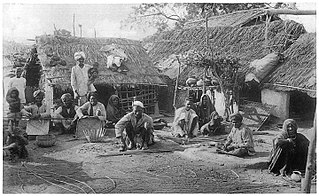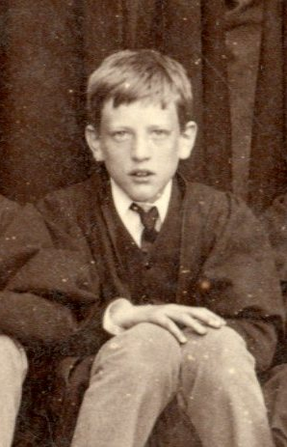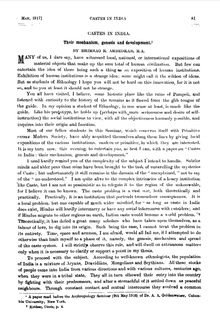
A caste is a fixed social group into which an individual is born within a particular system of social stratification: a caste system. Within such a system, individuals are expected to marry exclusively within the same caste (endogamy), follow lifestyles often linked to a particular occupation, hold a ritual status observed within a hierarchy, and interact with others based on cultural notions of exclusion, with certain castes considered as either more pure or more polluted than others. The term "caste" is also applied to morphological groupings in eusocial insects such as ants, bees, and termites.

Bhimrao Ramji Ambedkar was an Indian jurist, economist, social reformer and political leader who headed the committee drafting the Constitution of India from the Constituent Assembly debates, served as Law and Justice minister in the first cabinet of Jawaharlal Nehru, and inspired the Dalit Buddhist movement after renouncing Hinduism.
Jāti is the term traditionally used to describe a cohesive group of people in the Indian subcontinent, like a tribe, community, clan, sub-clan, or a religious sect. Each Jāti typically has an association with an occupation, geography or tribe. Different intrareligious beliefs or linguistic groupings may also define some Jātis. The term is often translated approximately in English as caste.
Endogamy is the cultural practice of mating within a specific social group, religious denomination, caste, or ethnic group, rejecting any from outside of the group or belief structure as unsuitable for marriage or other close personal relationships. Its opposite, exogamy, describes the social norm of marriage outside of the group.
Sanskritisation is a term in sociology which refers to the process by which castes or tribes placed lower in the caste hierarchy seek upward mobility by emulating the rituals and practices of the dominant castes or upper castes. It is a process similar to "passing" in sociological terms. This term was made popular by Indian sociologist M. N. Srinivas in the 1950s. Sanskritisation has in particular been observed among mid-ranked members of caste-based social hierarchies.

The caste system in India is the paradigmatic ethnographic instance of social classification based on castes. It has its origins in ancient India, and was transformed by various ruling elites in medieval, early-modern, and modern India, especially in the aftermath of the collapse of the Mughal Empire and the establishment of the British Raj. It is today the basis of affirmative action programmes in India as enforced through its constitution. The caste system consists of two different concepts, varna and jati, which may be regarded as different levels of analysis of this system.
Muslim communities has a system of social stratification arising from concepts other than "pure" and "impure", which are integral to the caste system in India. It developed as a result of relations among foreign conquerors, local upper-caste Hindus convert to Islam and local lower-caste converts (ajlaf), as well as the continuation of the Indian caste system by converts. Non-ashrafs are backward-caste converts. The concept of "pasmanda" includes ajlaf and arzal Muslims; ajlaf status is defined by descent from converts to Islam and by pesha (profession). These terms are not part of the sociological vocabulary in regions such as Kashmir and Uttar Pradesh, and say little about the functioning of Muslim society.

Sir Herbert Hope Risley was a British ethnographer and colonial administrator, a member of the Indian Civil Service who conducted extensive studies on the tribes and castes of the Bengal Presidency. He is notable for the formal application of the caste system to the entire Hindu population of British India in the 1901 census, of which he was in charge. As an exponent of scientific racism, he used anthropometric data to divide Indians into seven races.
The Ghosi are a Muslim community found mainly in North India. It is said that originally they were Ahirs who got converted to Islam.
The Kandera, Kadera, Golandāz, Bāndar, Hawāidar is a Hindu community found mainly in the northern and central regions of India. They belong to the Kshatriya varna. In earlier times, they were archers and arrow-makers. Later, they also became involved in roles such as cannon operators, firework crafters, and the production of gunpowder and iron missiles. The term "Kandera" is derived from the Sanskrit word "Kandir", which means "an archer".

Kumhar or Kumbhar is a caste or community in India, Nepal, Bangladesh and Pakistan. Kumhars have historically been associated with the art of pottery.
The Sikligar is a community found in the Indian states of Gujarat, Haryana, Rajasthan, and Punjab. By tradition, the Sikligar people specialized in the craft of making and polishing weapons. They are typically Hindu in Gujarat, Telangana, and Andhra Pradesh; Sikh in Punjab; and either Hindu and Sikh in Haryana.
The Bansphor are a Hindu caste found in the state of Uttar Pradesh, India.
The Bandhmati are a Hindu caste found in the state of Uttar Pradesh in India. They are also known as Banbasi.
The Heri are a Hindu caste found in the states of Haryana and Punjab in India.

Robert Vane Russell was a British civil servant, known for his role as Superintendent of Ethnography for what was then the Central Provinces of British India, coordinating the production of publications detailing the peoples of the region. Russell served as Superintendent of Census Operations for the 1901 Census of India.
The People of India is a title that has been used for at least three books, all of which focussed primarily on ethnography.
The Chokli are a Hindu caste found in Jammu and Kashmir. According to the 2001 Census of India, the caste had 18,866 members.

Suvira Jaiswal is an Indian historian. She is known for her research into the social history of ancient India, especially the evolution of the caste system and the development and absorption of regional deities into the Hindu pantheon.

Sundari paintings or Sundari images are a type of pin-up or erotic art that were popular in 19th-century Calcutta, in the province of Bengal in British India. Mostly sold as prints, the images depict women, particularly the new class of widows who took up sex work to survive, and are valuable references to understand the position of women in a society that was undergoing drastic shifts.









